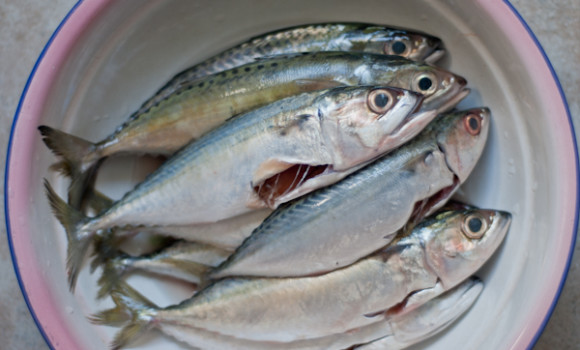While certain kinds of fish are high in mercury and other chemicals, small fish are a great pregnancy food, high in protein, B vitamins and good fats. It’s also quick and simple to fix: you can simply pan sear, serve with ginger, garlic or soy, roll up in fish tacos or grill white fish with slivers of bananas and almonds.
Fish is packed with nutrients that appears to boost fetal development and high in protein, vitamin D and healthy fats. Large studies have found correlations between moms who ate more than one serving of fish a week during pregnancy and babies with better communication skills, motor coordination and visual memory.
But then there’s the the risk of contamination from mercury and other dangerous pollutants, like PCBs, petrochemicals and pesticides. We know these can do bad things to a developing fetus, such as increasing the risk of birth defects and certain cancers and impairing cognitive development.
The higher up in the food chain a fish is, the more likely it is to be contaminated with pollutants. Shark, pike, albacore and yellowfin tuna, tilefish, marlin, king mackerel, swordfish and halibut are all likely to be contaminated with mercury. Mercury levels in salmon can vary a lot, with FDA salmon samples finding some with very low levels and other samples with dangerously high levels. Since 2004, the Food and Drug Administration has advised pregnant women to avoid consuming more than 6 ounces of tuna (and certain other fish) weekly because of the dangers of methylmercury contamination. However, the FDA warning was based on the assumption that tuna contains methylmercury concentrations of between 0.14 and 0.64 parts per million. In 2008 the New York Times sampled a variety of tuna sushi in New York City and found mercury concentrations that were much higher, from .10 to as high as 1.4 parts per million. (Bluefin tuna yielded the highest amounts, yellowfin had less.)
Further muddying the waters, genetic testing has found that fish is often mislabeled: consumers think they’re buying one species may actually be buying another. One FDA study found that 37 percent of seafood they tested was mislabeled, so it’s entirely possible that when you think you’re eating trout, it’s tilefish. Also, the FDA does not routinely test domestically caught fish for mercury or other pollutants.
Also:
- Avoid farmed salmon. Farm-raised salmon have been found to have high levels of PCBs and dioxins.
- Avoid rockfish, also known as black bass or striped bass, there have been numerous reports of rockfish with high levels of contaminants.
- Be careful with catfish and tilapia. While American farmed catfish and tilapia are safe, any catfish over two pounds, wild-caught or Asian farmed tilapia or catfish has a high risk of being contaminated with pollutants. If you’re not sure where your catfish or tilapia is from, avoid it.
Or, stick to only eating smaller fish and shellfish, which generally contain very low levels of mercury: anchovies, herring, sardines, shrimp, clams, oysters, and crabs are all pretty safe, and low-fat and healthy sources of protein. But avoid raw oysters or clams due to the risk of food poisoning.
Or you can choose to avoid fish entirely and take purified fish-oil supplements or cod-liver oil for the health benefits. While you won’t get protein this way, you will get the omega-3s and usually some vitamin D as well. The downside: lots of supplements cause unsavory “fish burps.” Bon appetit!



Leave a Comment